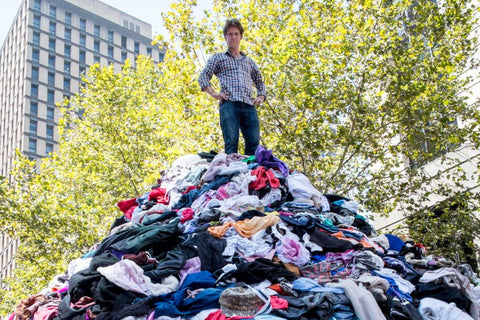STOP, BREATH, SLOW DOWN AND WATCH!
Watch one small Tasmanian company committed to creating slow quality fashion one stitch at a time keeping a dying tradition alive in Australia, creating jobs, showing small can be better for you, the environment and others!
SQ 30sec #1 from Jasper on Vimeo.
Did you know Australians are the world's second largest consumers of textiles, buying on average 27 kilograms of new clothing and other textiles each year? Scary?So what is the environmental impact of this obsession? And why should you care? What can we do to help?

War on Waste Craig Reucassel standing on top of a mountain of clothes in Martin Place.
The Aannual production forecasts from PCI Fibres found that while Australia sat just behind North America's need for new clothing, the amount of textiles we consumed annually was twice the global average of just 13 kilograms per person per year.
According to sustainability consultant Jane Milburn, two-thirds of the clothes and textiles bought are made of synthetic fibres which are derived from petroleum.
Plastic clothes don't decay.
While textiles made of natural fibres are biodegradable and much more healthy for the wearer, the majority of "fast fashion" textiles are made of synthetic fibres.
These man-made fibres are effectively plastic clothes that don't decay readily when they are sent off to landfill and they're shedding micro plastic particles along the way. There is a huge environmental consequence of our clothes that we are only just starting to come to grips with.
"Fast fashion produced from global supply chains is driving excessive purchasing of cheap new clothing often discarded after a few wears."
All this may make you feel like having a big deep sigh of despair, we see this as an opportunity to change attitudes!
Australians need to start thinking more about how they can reduce their clothing and textile footprint, how natural fibres are better for their health, how natural quality fibres last longer (reduces the need to replace quickly), make you sweat less and control temperatures (hot or cold) better. I can only see positives here, cant you?
In the same way we have become more aware of what we eat and want to know more about cooking and growing food, slowly we are becoming more conscious about what we wear and how this has an impact on us, our environment and those that make them.
If we know the basics about how clothes are made and where and by whom, we [can] value them and can make running repairs to extend their lifespan, buying quality slow fashion in classic styles creates a capsule wardrobe made up of natural fibres like wool, linen, bamboo and organic cottons last a life time.
Imagine what you can achieve by supporting slow fashion created right here in Australia? The benefits to you, your community, the local economy and the environment are so huge it is almost unimaginable...and that's just the beginning!
SQ 30sec #2 from Jasper on Vimeo.
"We ask you to please support small local "slow" production, make a difference today and LOVE the clothes you wear and feel proud that you are making the changed needed".
Cheers Tamika
Designer/ Director The SQ Studio


